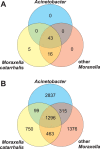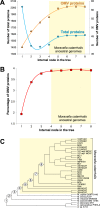Virulence factors of Moraxella catarrhalis outer membrane vesicles are major targets for cross-reactive antibodies and have adapted during evolution
- PMID: 29563531
- PMCID: PMC5862889
- DOI: 10.1038/s41598-018-23029-7
Virulence factors of Moraxella catarrhalis outer membrane vesicles are major targets for cross-reactive antibodies and have adapted during evolution
Abstract
Moraxella catarrhalis is a common human respiratory tract pathogen. Its virulence factors associated with whole bacteria or outer membrane vesicles (OMVs) aid infection, colonization and may induce specific antibodies. To investigate pathogen-host interactions, we applied integrated bioinformatic and immunoproteomic (2D-electrophoresis, immunoblotting, LC-MS/MS) approaches. We showed that OMV proteins engaged exclusively in complement evasion and colonization strategies, but not those involved in iron transport and metabolism, are major targets for cross-reacting antibodies produced against phylogenetically divergent M. catarrhalis strains. The analysis of 31 complete genomes of M. catarrhalis and other Moraxella revealed that OMV protein-coding genes belong to 64 orthologous groups, five of which are restricted to M. catarrhalis. This species showed a two-fold increase in the number of OMV protein-coding genes relative to its ancestors and animal-pathogenic Moraxella. The appearance of specific OMV factors and the increase in OMV-associated virulence proteins during M. catarrhalis evolution is an interesting example of pathogen adaptation to optimize colonization. This precisely targeted cross-reactive immunity against M. catarrhalis may be an important strategy of host defences to counteract this phenomenon. We demonstrate that cross-reactivity is closely associated with the anti-virulent antibody repertoire which we have linked with adaptation of this pathogen to the host.
Conflict of interest statement
The authors declare no competing interests.
Figures






References
-
- Hays JP. Moraxella catarrhalis: a mini review. J. Pediatric Infect. Dis. 2009;4:211–220.
Publication types
MeSH terms
Substances
LinkOut - more resources
Full Text Sources
Other Literature Sources
Molecular Biology Databases

